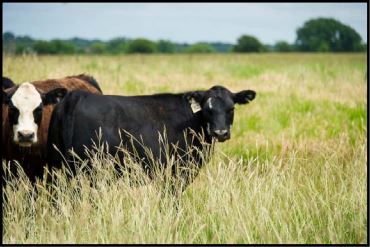
By Kris Ringwall, Beef Specialist, NDSU Extension
Cattle are in the pasture, but how many should be there?
The answer to that question is the heart of a beef operation. Proper utilization of grass is critical.
Overutilization will impact the plant community negatively; underutilization impacts the plant community by not allowing for the proper stimulation of plant growth. The answer relates to what is the proper stocking rate for a given pasture.
Miranda Meehan, NDSU Extension livestock environmental stewardship specialist, says, “Setting the stocking rate is one of the most important decisions that ranchers or land managers make. The stocking rate is the number of specific kinds and classes of animals grazing or using a unit of land for a specific time period.
“Regardless of which grazing management system is employed, vegetation type grazed or kind and class of livestock involved, stocking rate has the largest impact on the health of the grassland resource and animal performance of all management tools available,” she adds.
The stocking rate discussion becomes a discussion of carrying capacity.
“When setting the stocking rate, knowing the carrying capacity of the pasture is critical,” Meehan notes. “Carrying capacity is a measure of how much forage a grazing unit has and is able to produce in an average year. The carrying capacity is the maximum stocking rate possible that is consistent with maintaining or improving forage production and vegetation composition, and other related resources.”
Determining carrying capacity is not simple. However, the time producers take to better understand how carrying capacity is determined is very beneficial. A visit with a range specialist to get a broader understanding of major land resource areas and ecological sites is helpful, but in the end, the correct answer to just how many cattle are turned out and how long they will be grazing a set pasture is critical.
The better the understanding and acceptance of the information that calculates the stocking rate, the less likely a producer is going to arbitrarily adjust the number of cow-calf pairs turned into a pasture and/or the period of time they will be in a pasture.
The temptation to simply look at the waving grass, open the gate and come back later to adjust the number of cattle is not good. Do not give in to quick thoughts, but rather come to appreciate the amount of current and historical information involved in the evaluation of ecological sites and summer forage availability, and correctly calculate the number of cattle.
The number of cattle is converted to animal unit months for proper calculation of full-season grazing plans.
“Carrying capacity is also defined as the amount of forage available for grazing animals, expressed as the number of available animal unit months, or number of animal units grazed for one month,” Meehan explains.
So how does one actually bring the vast amount of knowledge known regarding grazing systems and stocking rate to a practical level? Meehan answers the question.
“The most accurate way to calculate carrying capacity is to calculate forage production using the clip-and-weigh method,” she says. “This method requires the harvesting of standing forage at a given time to predict available forage. The available forage is measured by hand clipping and weighing plots within a grazing unit.”
The process is a valuable tool as cow-calf producers prepare for the summer’s grazing season.
“To ensure the health of your grazing resources, it is important that the stocking rate does not exceed the carrying capacity,” Meehan stresses. “Although these calculations are complicated, through the help of modern computer skills, these averages are easier to get, and certainly through the assistance of the Natural Resources Conservation Service (NRCS) or NDSU Extension, through their local offices, the needed information can be gathered up and reviewed.”
She adds: “A variety of factors can influence the amount of forage available for livestock consumptions, including precipitation and management. Many producers are seeing a decline in forage production as a result of the 2017 drought. It is important that they are adjusting their stocking rates to prevent overgrazing, resulting in further loss in forage production.”
NDSU Extension has developed a set of grazing management tools:
- “Determining Carrying Capacity and Stocking Rates for Range and Pasture in North Dakota,” a publication (http://tinyurl.com/CarryingCapacityStockingRates)
- “NDSU Extension Range and Forage Production Sample Kits,” a publication (https://tinyurl.com/NDSU-RangeSampleKits)
- NDSU Grazing Calculator app, which is available for Android and Apple devices in the Google Play store (https://tinyurl.com/Google-NDSUgrazingapp) and Apple App Store (https://tinyurl.com/apple-NDSUgrazingapp).
The ultimate goal: a healthy plant community for grazing.
Source: NDSU BeefTalk



Leave A Comment